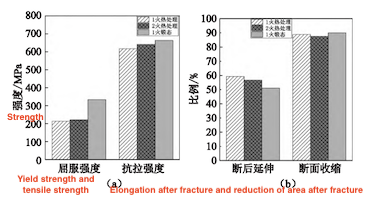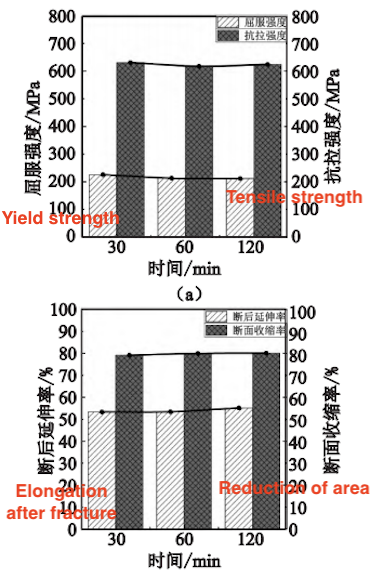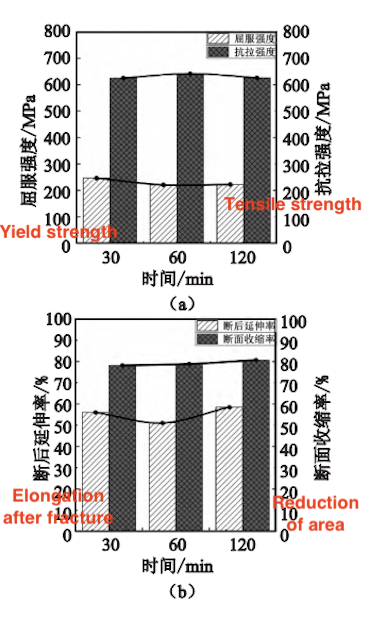Mechanical Properties of Forged Stainless Steel 321 Valves(Part Two)
Mechanical Properties of Forged Stainless Steel 321 Valves(Part Two)
May 22, 2024
3. Experimental results and discussion of forged stainless steel 321 valves
3.1 Research on the forging process
Testing the mechanical properties of forged materials can provide a reference for studying the evaluation of forging effects and analyzing post-forging heat treatment data. Figure 1 shows the mechanical properties of sample 321 after one-heating forging. After repeated testing for three times, the average yield strength, tensile strength, elongation at break and shrinkage of area of all samples were significantly higher than the standard requirements (GB/T 1220-2016).

Figure 1 Engineering stress-strain curve of forged stainless steel 321
Figure 2 shows the mechanical properties of two forged samples under the same heat treatment conditions (1050°C for 60 minutes). Figure 2(a) shows that the strength of the forged valve is significantly higher than that of the heat-treated sample, and the yield strength and tensile strength of the two-heating forged sample are slightly higher than those of the one-heating forged sample. Figure 2(b) shows that the post-fracture elongation of the forged sample is significantly lower than that of the heat-treated sample, and the one-heating sample maintains slightly higher elongation and shrinkage than the two-heating sample. The strength of the two-heating forging sample increases and the plasticity decreases, which can be attributed to the mutual restriction of material strength and toughness.

(a) Yield strength and tensile strength (b) Elongation after fracture and reduction of area after fracture
Figure 2 Tensile properties of samples at room temperatures forged by different processes
3.2 Research on heat treatment
The mechanical properties of stainless steel 321 with different holding temperature at a temperature of 1050°C were tested. Figure 3 shows that when the one-heating sample is heat-treated for 30 to 120 minutes, the yield strength shows a downward trend with time, Although the maximum yield strength of 226MPa is obtained in 30 minutes, the yield strength of the material decreases by nearly 32% compared to the forged state of 334MPa. The maximum tensile strength also reaches 631MPa at 30 minutes, and drops to 617 to 624MPa at 60 to 120 minutes. Compared with the forged state, the tensile strength is reduced by 5% to 7%. Overall, the strength of the samples held for 30 to 120 minutes meets the national standard requirements.

(a) Yield strength and tensile strength (b) Elongation after fracture and reduction of area
Figure 3 Mechanical properties of one-heating forged samples under different heat treatments
Contrary to the change in strength, extending the solid solution time will increase the grain size and reduce the plastic toughness. For the one-heating sample, after heat treatment for 30 to 120 minutes, the elongation is above 53% and the shrinkage 79%. The area reduction of the heat-treated state is close to that of the forged state, but the elongation is higher than that of the forged state, with an increase of 17%. Compared with the forged state, the grains are more uniform after solution heat treatment, while the internal stress is reduced. The probability of crack initiation is reduced, and it is beneficial to improve the plastic toughness.
Figure 4 shows the mechanical test results of the heat treatment state of the two-heating sample. Compared with the one-heating sample, it can be seen that the yield strength of the two-heating material has increased significantly. The yield strength of the two-heating material is 246MPa at 30 minutes, which is nearly 9% higher than that of the one-heating. The yield strength of the two-heating material is increased by 5% on average compared with the one-heating, and the tensile strength is increased by 1% on average compared with the one-heating. The elongation of the two-heating sample maintained for 30 to 120 minutes was greater than 51%. The area reduction is close to that of the one-heating, reaching a maximum of 80%.
3.3 Studying microstructure
The metallographic analysis of the one-heating forged sample and the two-heating forged sample shows that: the average grain size of the one-heating sample is 28μm, and the average grain size of the two-heating sample is 24μm; both have the same metallographic rating 7.5 in GB/T 6394-2002.

(a) Yield strength and tensile strength (b) Elongation after fracture and reduction of area
Figure 4 Mechanical properties of two-heating forging samples under different heat treatments
(a) One-heating forging (b) Two-heating forging
Figure 5 Metallographic structures of samples with different forging processes
Structure determines performance. For general steel, the influence of structure on strength can be viewed from the following four aspects: (1) Solid solution strengthening (2) Dislocation strengthening (3) Precipitation strengthening (4) Fine grain strengthening. Since there are less precipitation phases in SS321, the precipitation strengthening effect is almost negligible. With the same heat treatment, the solid solution strengthening of the material is approximately unchanged. The dislocations generated by forging deformation will disappear greatly after heat treatment, while the fine-grain strengthening increases with the increase of forging passes. Therefore, the strengthening method of two-heating forging is mainly fine grain strengthening, but recovery and recrystallization in the solid solution process lead to a decrease in dislocation strengthening; the final material strength is closely related to the grain size. Therefore, fine grain strengthening is the main reason for the improvement in strength after the forging process is improved. Of course, further improving the forging process and optimizing the structure are important directions for future research.
4. Conclusion
Forging and heat treatment are used to manufacture stainless steel 321 forging blanks. The effects of forging and heat treatment processes on the mechanical properties of the forging blanks are analyzed, and the following conclusions are obtained:
(1) Stainless steel 321 forging billets that are forged with one-heating or two-heating and heat treated at 1050℃for 30 to 120 minutes can meet the national standard requirements for strength, elongation and section shrinkage.
(2) Compared with one-heating forging, the two-heating forged stainless steel 321 billet has a smaller grain size, giving it higher strength. Among them, the yield strength increased by 9% and the tensile strength 1%.
3.1 Research on the forging process
Testing the mechanical properties of forged materials can provide a reference for studying the evaluation of forging effects and analyzing post-forging heat treatment data. Figure 1 shows the mechanical properties of sample 321 after one-heating forging. After repeated testing for three times, the average yield strength, tensile strength, elongation at break and shrinkage of area of all samples were significantly higher than the standard requirements (GB/T 1220-2016).

Figure 1 Engineering stress-strain curve of forged stainless steel 321
Figure 2 shows the mechanical properties of two forged samples under the same heat treatment conditions (1050°C for 60 minutes). Figure 2(a) shows that the strength of the forged valve is significantly higher than that of the heat-treated sample, and the yield strength and tensile strength of the two-heating forged sample are slightly higher than those of the one-heating forged sample. Figure 2(b) shows that the post-fracture elongation of the forged sample is significantly lower than that of the heat-treated sample, and the one-heating sample maintains slightly higher elongation and shrinkage than the two-heating sample. The strength of the two-heating forging sample increases and the plasticity decreases, which can be attributed to the mutual restriction of material strength and toughness.

(a) Yield strength and tensile strength (b) Elongation after fracture and reduction of area after fracture
Figure 2 Tensile properties of samples at room temperatures forged by different processes
3.2 Research on heat treatment
The mechanical properties of stainless steel 321 with different holding temperature at a temperature of 1050°C were tested. Figure 3 shows that when the one-heating sample is heat-treated for 30 to 120 minutes, the yield strength shows a downward trend with time, Although the maximum yield strength of 226MPa is obtained in 30 minutes, the yield strength of the material decreases by nearly 32% compared to the forged state of 334MPa. The maximum tensile strength also reaches 631MPa at 30 minutes, and drops to 617 to 624MPa at 60 to 120 minutes. Compared with the forged state, the tensile strength is reduced by 5% to 7%. Overall, the strength of the samples held for 30 to 120 minutes meets the national standard requirements.

(a) Yield strength and tensile strength (b) Elongation after fracture and reduction of area
Figure 3 Mechanical properties of one-heating forged samples under different heat treatments
Contrary to the change in strength, extending the solid solution time will increase the grain size and reduce the plastic toughness. For the one-heating sample, after heat treatment for 30 to 120 minutes, the elongation is above 53% and the shrinkage 79%. The area reduction of the heat-treated state is close to that of the forged state, but the elongation is higher than that of the forged state, with an increase of 17%. Compared with the forged state, the grains are more uniform after solution heat treatment, while the internal stress is reduced. The probability of crack initiation is reduced, and it is beneficial to improve the plastic toughness.
Figure 4 shows the mechanical test results of the heat treatment state of the two-heating sample. Compared with the one-heating sample, it can be seen that the yield strength of the two-heating material has increased significantly. The yield strength of the two-heating material is 246MPa at 30 minutes, which is nearly 9% higher than that of the one-heating. The yield strength of the two-heating material is increased by 5% on average compared with the one-heating, and the tensile strength is increased by 1% on average compared with the one-heating. The elongation of the two-heating sample maintained for 30 to 120 minutes was greater than 51%. The area reduction is close to that of the one-heating, reaching a maximum of 80%.
3.3 Studying microstructure
The metallographic analysis of the one-heating forged sample and the two-heating forged sample shows that: the average grain size of the one-heating sample is 28μm, and the average grain size of the two-heating sample is 24μm; both have the same metallographic rating 7.5 in GB/T 6394-2002.

(a) Yield strength and tensile strength (b) Elongation after fracture and reduction of area
Figure 4 Mechanical properties of two-heating forging samples under different heat treatments
(a) One-heating forging (b) Two-heating forging
Figure 5 Metallographic structures of samples with different forging processes
Structure determines performance. For general steel, the influence of structure on strength can be viewed from the following four aspects: (1) Solid solution strengthening (2) Dislocation strengthening (3) Precipitation strengthening (4) Fine grain strengthening. Since there are less precipitation phases in SS321, the precipitation strengthening effect is almost negligible. With the same heat treatment, the solid solution strengthening of the material is approximately unchanged. The dislocations generated by forging deformation will disappear greatly after heat treatment, while the fine-grain strengthening increases with the increase of forging passes. Therefore, the strengthening method of two-heating forging is mainly fine grain strengthening, but recovery and recrystallization in the solid solution process lead to a decrease in dislocation strengthening; the final material strength is closely related to the grain size. Therefore, fine grain strengthening is the main reason for the improvement in strength after the forging process is improved. Of course, further improving the forging process and optimizing the structure are important directions for future research.
4. Conclusion
Forging and heat treatment are used to manufacture stainless steel 321 forging blanks. The effects of forging and heat treatment processes on the mechanical properties of the forging blanks are analyzed, and the following conclusions are obtained:
(1) Stainless steel 321 forging billets that are forged with one-heating or two-heating and heat treated at 1050℃for 30 to 120 minutes can meet the national standard requirements for strength, elongation and section shrinkage.
(2) Compared with one-heating forging, the two-heating forged stainless steel 321 billet has a smaller grain size, giving it higher strength. Among them, the yield strength increased by 9% and the tensile strength 1%.
Next: Understanding Forged Valve Pressure Ratings for Industrial Safety
Previous: Mechanical Properties of Forged Stainless Steel 321 Valves(Part One)
News
About Us
Best Categories
Useful Links